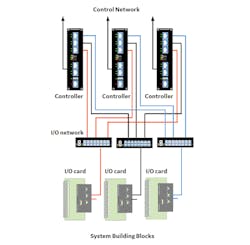Just when you think everything new in the industry is really just a series of upgrades, manufacturers surprise you with some serious innovations. But given the ever-escalating complexity of manufacturing systems, the exponential growth of connections among devices and workers that is the Internet of Things (IoT), and the persistent threat from cybersecurity and safety realms, innovation is exactly what is needed.
GE is talking about an innovation in the Ethernet backbone that could lead to significant improvements in process control systems. Taking the pervasive, low-cost communications layer down to the lowest level of control system architecture could provide the connectivity and integration needed in the IoT manufacturing environment.
It was more than a year ago that ExxonMobil began its push against automation suppliers to simplify the I/O scene that has become a tangle of wires connected to hundreds of junction boxes and I/O cabinets. Marshaling cabinets simplify matters, but it’s not enough. The oil and gas producer can spend up to a year just doing factory acceptance tests (FATs), making costly design changes in the field after that. The situation has to change.
“If we’re only improving the way we’ve been doing things, at best we’ll have incremental improvement. That’s just not enough,” said Sandy Vasser, facilities instrumentation and electrical manager for ExxonMobil Development, at a conference last April. “We have to challenge traditional practices and technologies and look for opportunities to make giant leaps in improvements.”
Ethernet communications has become so common in process industries, exchanging data among control systems and on up to the enterprise level. But the lowest level of the architecture, the rack, has remained burdened by restrictive I/O configurations. Because of the increasing ubiquity of Ethernet, it is now viable as a flexible, high-speed, low-cost option at the lowest level of communication as well.
Introducing Ethernet as a control system backplane provides flexibility to add and subtract I/O as needed, reducing costs, improving distributability, and simplifying overall control system architecture. Rather than be restricted to a fixed number of I/O cards, Ethernet backbone architecture can be scaled easily from a single I/O cards to 100. In fact, a single I/O card would not likely be feasible in a rack-based system because the capability would be too greatly reduced. But combining onboard power distribution and Ethernet connectivity make a single I/O card possible.
Ethernet would also provide flexibility for redundancy schemes, GE says. For example, if safety instrumented functions (SIFs) have different redundancy requirements in the same controller, a traditional rack-based architecture would require the highest level of redundancy for all SIFs. “Ethernet-based systems can use redundancy (especially for I/O modules) as required, allowing some SIFs to use simplex I/O, and other SIFs to sue redundant I/O,” GE explains. “I/O modules can even be changed from simplex to redundant, or the reverse, if SIF requirements change, without affecting the I/O structure of any other SIFs.”
Proprietary communication technologies have long been an issue for producers. But that becomes less and less important, GE says, as more Ethernet-based innovations enter the marketplace. “Use of Open Ethernet standard physical technology allows a lower cost for innovation for the life of the control system. Completely new I/O functionality can be integrated into installed systems without costly ripouts.”
You can read GE’s full argument for an Ethernet backbone from a PDF at ISA’s website.

